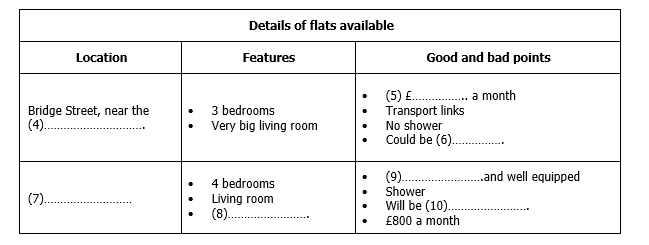SECTION 11
Questions 1-3
Choose the correct letter A, B or C.
1. What is Martin’s occupation?
A he works in a car factory
B he works in a bank
C he is a college student
2. The friends would prefer somewhere with
A 4 bedrooms
B 3 bedrooms
C 2 bathrooms
3. Phil would rather live in
A the east suburbs
B the city centre
C the west suburbs
Questions 4-10
Complete the table below. Write NO MORE THAN THREE WORDS AND/ OR A NUMBER for each answer.

(4) (5)
(6) (7)
(8) (9)
(10)
SECTION 2
Questions 11-15
Complete the sentences below. Write NO MORE THAN THREE WORDS for each answer.
The British Library
11. The reading rooms are only open for group visits on …………………….
12. The library was officially opened in …………………….
13. All the library rooms together cover ……………………. meter square.
14. The library is financed by the …………………….
15. The main function of the library is to provide resources for people doing …………………….
Questions 16-20
Label the plan below. Write NO MORE THAN THREE WORDS for each answer.

(16) (17)
(18) (19)
(20)
SECTION 3
Questions 21-25
Choose the correct answer A. B or C
Project on work placement
21. The main aim of Dave’s project is to
A describe a policy.
B investigate an assumption.
C identify a problem.
22. Dave’s project is based on schemes in
A schools.
B colleges.
C universities.
23. How many academic organisations returned Dave’s questionnaire?
A 15
B 50
C 150
24. Dave wanted his questionnaires to be completed by company
A Human Resources Managers.
B Line Managers.
C owners.
25. Dr Green wants Dave to provide a full list of
A respondents.
B appendices.
C companies.
Questions 26-30
Complete the notes below. Write NO MORE THAN TWO WORDS for each answer.
Notes on project
Introduction
– improve the (26) …………………….of ideas
– include a (27) …………………….of ‘Work Placement’
– have separate sections for literature survey and research (28)……………………. and methods
Findings
Preparation stage – add summary
(29) ……………………. development – good
Constraints on learning – provide better links to the (30) …………………….from research
SECTION 4
Questions 31-35
Complete the sentences below. Write NO MORE THAN THREE WORDS for each answer.
Bilingualism can be defined as having an equal level of communicative (31) …………………….in two or more languages.
Early research suggested that bilingualism caused problems with (32) …………………….and mental development.
Early research into bilingualism is now rejected because it did not consider the (33) ……………………. backgrounds of the children
It is now thought that there is a (34) …………………….bilingualism and cognitive skills in children.
Research done by Ellen Bialystok in Canada now suggests that the effects of bilingualism also apply to (35) …………………….
Questions 36-40
Choose the correct letter A, B or C.
36 In Dr Bialystok’s experiment, the subjects had to react according to
A the colour of the square on the screen.
B the location of the square on the screen.
C the location of the shift key on the keyboard.
37 The experiment demonstrated the ‘Simon effect’ because it involved a conflict between
A seeing something and reacting to it.
B producing fast and slow reactions.
C demonstrating awareness of shape and colour.
38 The experiment shows that, compared with the monolingual subjects, the bilingual subjects
A were more intelligent.
B had faster reaction times overall.
C had more problems with the ‘Simon effect’
39 The results of the experiment indicate that bilingual people may be better at
A doing different types of tasks at the same time.
B thinking about several things at once.
C focusing only on what is needed to do a task.
40 Dr Bialystok’s first and second experiments both suggest that bilingualism may
A slow down the effects of old age on the brain.
B lead to mental confusion among old people.
C help old people to stay in better physical condition
ANSWER
1. B
2. A
3. C
4. bus station
5. 450
6. noisy
7. hills avenue
8. dining room
9. modern
10. quiet
11. sundays
12. 1998
13. 100000
14. government
15. research
16. conference centre
17. information desk
18. bookshop
19. king’s library
20. stamp display
21. B
22. C
23. A
24. B
25. A
26. organisation
27. definition
28. aims
29. key skills
30. evidence
31. proficiency
32. learning
33. social and economic
34. positive relation between
35. adults
36. A
37. A
38. B
39. C
40. A
